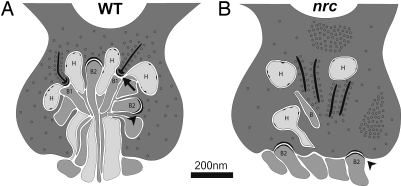Fig. 1.
Diagram of photoreceptor terminals in WT and nrc mutant zebrafish at 5 dpf. (A) In the WT retina, bipolar and horizontal cell processes invaginate into the pedicle in a tight bundle to make two types of junctions: ribbon synapses (arrow) and flat contacts (arrowhead). Ribbon synapses are made onto presumed ON bipolar (B1) and horizontal (H) cell dendrites. Synaptic vesicles surround the synaptic ribbon. Flat contacts are found between the ribbon synapses and have dense cytoplasmic material on both sides of the junction. (B) In the nrc retina, few processes invaginate into the photoreceptor terminals. However, when present, many of these processes have small membrane densities, characteristic of horizontal cell processes. Synaptic ribbons in most of the pedicles are unassociated with postsynaptic processes and appear to be floating. However, flat contacts (arrowhead) are seen onto presumed OFF bipolar cell (B2) dendrites. However, they are displaced and make junctions at the photoreceptor base, rather than within the photoreceptor terminal. Synaptic vesicles often clump and fail to distribute evenly in nrc pedicles, but they surround synaptic ribbons as they do in WT pedicles. Based on Allwardt et al. (8).

